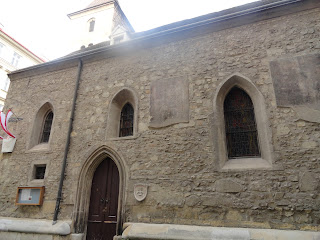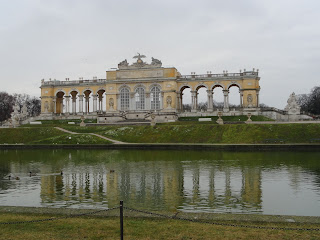I feel that it's only fitting that this post about Vienna, or Wien, as they call it, beings with a statue of Maria-Theresia, one of the most famous leaders in the Hapsburg Family. Vienna is a great city with easy access to all the sites, simple public transportation, fun above-ground trams and a big ring with famous buildings all built up in a big circle. The Rathaus (City Hall) and Parliament are next to teach other and the various squares are market by gorgeous Gothic and Romanesque Cathedrals like St. Michaels, St. Rufus and St. Stephen's. In a city known for its leaders, like Maria-Theresa and Franz-Joseph, for composers like Beethoven, Mozart and Schubert, for thinkers like members of the Secession and Freud, there are bound to be many statues and memorials all over the city.
 |
| National Library Building |
 |
| The Art History Museum |
 |
| Outside Parliament |
 |
| Parliament building |
 |
| The Rathaus |
 |
| Holocaust Memorial |
 |
| oldest church in Viena |
 |
| Mozart Memorial |
Vienna likes its multi-museum tickets and we bought one that got us into the Ephesus Museum, the Music Museum and the Armor Museum. I loved the sculptures from the Ephesus Museum, especially the one below of Trajan, Hadrian, Lucius and Marcus Aurelius. We kind of forgot about the Armor Museum before it was too late so we ended up spending WAY too much time listening to the audio guide in the Music Museum and then ran around the rest of the Armor part, disappointed that we had not divided our time better. The musical instruments, as well as the commentary, was interesting but we had already been to a musical instrument museum in Barcelona and come on, armor and knights are the BEST! We also got into the special treasury that specialized in royal garments and artifacts, including massive golden goblets and ornate cradles (seriously, it's no wonder that all these monarchies ended up crashing and burning...) as well as religious garb, including priest vestments.












Where Vienna lacks in castles, they make up for in Palaces. Shiri and I went up to Schonbrunn Palace, which was considered the "Summer Home" of Maria-Theresia and Joseph and then later Franz Joseph and Sissi. We didn't go inside but the grounds, the gardens, the arch that commemorates nothing at all (but it's bigg.. bigger than the arches in other cities), the massive fountain, they are all clear representations of the power of the Age of Absolutism and the monarchs that reigned. I also spent a morning at the Hofburg, the former residential home of the emperors and emperesses. You weren't allowed to take pictures inside but one ticket gave me access to the Royal Treasury, the Sissi Museum and the Royal Apartments. I was amazed at the simplicity of the Royal Apartments, especially after having seen the opulence and ornate nature of the rooms in manor houses like Chatsworth or palaces like Hampton Court. The Treasury was just cabinet after cabinet full of gold and silver flatware, plates, cups, bowls, serving trays, serving bowls, porcelain sets, specially folded napkins, ornamental dishes, practical dishes, etc. I never thought that dishes could be so fascinating. Ikea this is NOT at all. The Sissi Museum is dedicated to the myth of the beloved and misunderstood Empress of Austria who was adored by her husband Franz-Joseph, although she hated life at court and was frequently off spending time away from her family in other places around the world. What is probably most fascinating about her was her assassination. An Italian anarchist was originally planning to assassinate a French diplomat but when discovered Sissi was about to board her ship, he changed his plans. He quickly stabbed her in the chest and she just fell over, thinking someone had knocked into her. Later on the boat, she collapsed and they found a small but clearly fatal wound. As usually happens with assassinations, all criticisms is gone and a myth arises and that certainly happened with Sissi.




The Kunsthistorisches Museum, or the Art History Museum, was absolutely phenomenal. Not only was it in this huge, ornate, Baroque style building with the most gorgeous interiors, it had so many of my favorite piece sof art and history. The first floor was all Greco-Roman art and artifacts, including glorious statues, Hellenistic representations of the human form, coins, and beautiful jewelry. There was also a large Egyptian section and that's a time period I'm incredibly fascinated with. It all reminds me of my first semester Ancient Civ class with Mark. I also loved how the ceilings of the rooms reflected the artifacts found inside. Upstairs were the Old Masters, French, Italian, Flemish and Spanish painters like Velasquez, Rubens, Cranach, Carravaggio, Raphael, etc. The vast amount of paintings in each room was astounding and I easily could have spent many more hours there.











I also spent a slightly warmer afternoon out at the cemetery, where many Austrian dignitaries are buried. Probably their most famous section is their music section, which had the graves of BEETHOVEN (my favorite!), Mozart, Strauss, Schubert, among many others. My favorite things about wandering through the thousands of headstones was that it was truly a reflection of what the Austrian Empire had once been like. There were German sounding names, Slavish sounding names, Czech/Slovakian sound names, all reflection and reminding that Austria once had been the Austrian-Hungarian Empire and stretched all the way to the Black Sea. The stark trees were so beautiful and the crows that were perching on the headstones were not at all un-creepy...
And also let's not forget the BEST part of Austria- schnitzel and Austrian mac 'n cheese that has a really long complicated name, and caffe lattes and Sacher Torte. It was all so delicious!























































No comments:
Post a Comment